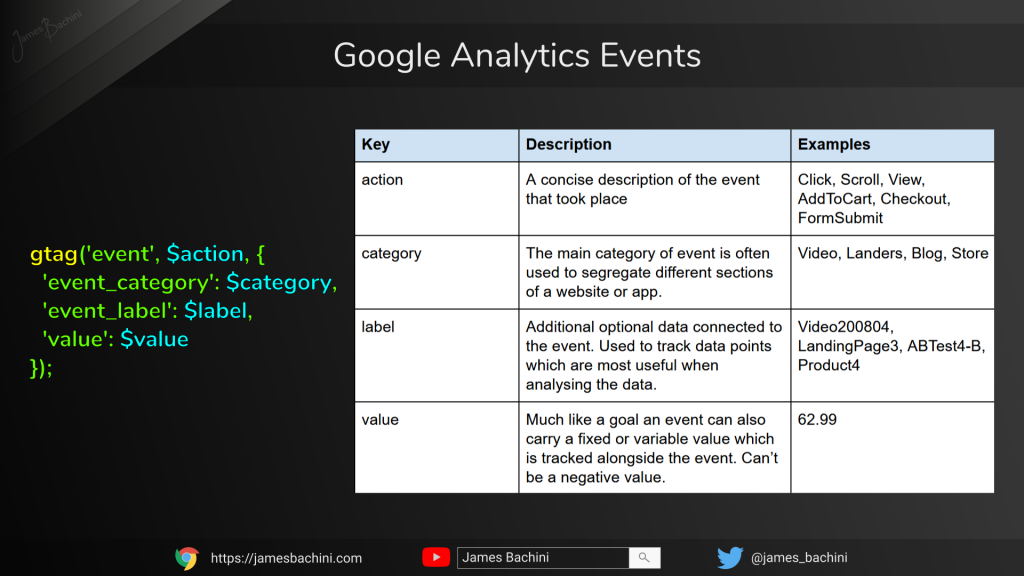The 9-Second Trick For Google Analytics Event Tracking
Table of ContentsExcitement About Google Analytics Event TrackingThe 7-Minute Rule for Google Analytics Event TrackingGoogle Analytics Event Tracking for DummiesOur Google Analytics Event Tracking StatementsThe smart Trick of Google Analytics Event Tracking That Nobody is Talking AboutGoogle Analytics Event Tracking Can Be Fun For Everyone

If you're mosting likely to establish event tracking manually, after that you're going to have to include some added code to the components you intend to collect data from. The code you're going to deal with will look something like this: There are four elements within that code snippet that you're going to require to define yourself: event, Group, event, Activity, occasion, Label and event, Worth.
As you can see, 2 of these are needed (category and action) while tag and worth are optional. All of it depends on the kind of info you want passed on back to Google Analytics when an individual clicks the specified element (Google Analytics Event Tracking). It will certainly be a lot easier to specify these elements if you analyse your web site and determine which elements/actions you want to track
Excitement About Google Analytics Event Tracking
Now, you'll be asked to define the and and you'll wish to select from the drop-down food selection that appears when you click. This will certainly bring up the exact same occasion monitoring components we took a look at earlier, which you'll require to complete. When you have actually defined these, you can move to the 2nd box and select the trigger that will certainly discharge your tag.
On the next screen, you'll additionally have a field for naming your trigger and, if you click on the box, you'll see a listing of the various triggers you can choose. In this case, we desire to choose and afterwards select the option listed below. After that you'll set the trigger to only discharge when an element is clicked with a link that contains the.
Every website talks. Prior to information analytics, we could not hear the voices of our web sites. But how do you recognize what your site is stating? Straightforward - Event directory monitoring! Event monitoring provides you an image of how individuals engage with your web site and business (Google Analytics Event Tracking). Do you need to know even more? After that, continue reading as we check out every little thing you require to recognize, including what it is, why you should track events, how to manage events information, and various other relevant FAQs you may have.
Rumored Buzz on Google Analytics Event Tracking
You can i was reading this switch over between your event classifications, activities, and tags in the Top Events report. The Event Pages report shows the web pages where occasions are triggered.
It shows you the course they take as they relocate from one event to the next and assists you to determine which content engages your target market one of the most. Events in Google Analytics have four primary components. They are additionally a part of the event tracking code. Google Analytics utilizes these codes to track individual communications and group them into event records.
A listing of the specifications you can track on your web site is on the. After inspecting all necessary areas, you can click "X" to shut the window and return to the Summary menu on the.
Some Known Details About Google Analytics Event Tracking

Picking "False" will avoid that session from being a bounce. If you have not done so, you may need to establish a variable in the Google Analytics Setups box. Click "New Variable ..." if you can not locate one to pick. After this, enter your GA tracking ID in the Tracking ID field.
To do this, comply with the next series of activities: After setting up the areas, choose the "Triggering" section. When configuring your new trigger, click the "+" button, then the "pencil" button, after that pick your trigger kind.
What Does Google Analytics Event Tracking Mean?

When it comes to knowing which sections and have a peek at this website components are leading consumers through your conversion funnel, you still won't know. So, without event tracking, GA records will only count sees as single-page sessions, also if customers invest a lot of time on one page and engage with it substantially (and a bounce).
How does event monitoring achieve this?Single-web page sessions known as bounces begin and conclude on the exact same web page. Without event monitoring, GA will certainly categorize a customer's check out as a bounce if they do not navigate to one more web page, despite exactly how they interact with it. As an example, a video-rich web page can have a higher bounce rate if occasions are not tracked.
Google Analytics Event Tracking Things To Know Before You Buy
Nevertheless, for GA to take event hits into account when determining bounce rates, you need to pick "Non-interaction occasion" as "False" throughout the GTM configuration. Setting "occasion objectives" with occasion activity is an exceptional method to monitor individual activities you value highly, such as brand-new lead entries or click a phone call to action.